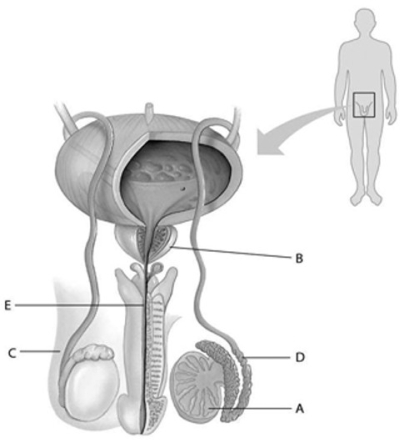A) determination
B) cleavage
C) fertilization
D) induction
E) gastrulation
Correct Answer

verified
Correct Answer
verified
Multiple Choice
Refer to the accompanying figure, which diagrams the reproductive anatomy of the human male, to answer the question(s) below.  -In the figure, which letter points to the urethra?
-In the figure, which letter points to the urethra?
A) A
B) B
C) C
D) D
E) E
Correct Answer

verified
Correct Answer
verified
Multiple Choice
Which of the following statements support the hypothesis that the onset of puberty is related to nutritional state? I. On average, puberty occurs at a younger age now than it did 200 years ago. II. Girls with large fat stores generally enter puberty earlier than thin girls do. III. The nutritional state of the U.S. population is much better than it was 200 years ago.
A) only I and III
B) only II and III
C) only I and II
D) only II
E) I, II, and III
Correct Answer

verified
Correct Answer
verified
Multiple Choice
Changes in cell position occur extensively during ________.
A) organogenesis, but not during gastrulation or cleavage
B) cleavage, but not during gastrulation or organogenesis
C) fertilization and cleavage, but not during gastrulation
D) gastrulation and cleavage
E) gastrulation
Correct Answer

verified
Correct Answer
verified
Multiple Choice
Ovulation is the follicular response to a burst of secretion of ________.
A) luteinizing hormone (LH)
B) progesterone
C) inhibin
D) prolactin
E) estradiol
Correct Answer

verified
Correct Answer
verified
Multiple Choice
Peaks of luteinizing hormone (LH) and follicle-stimulating hormone (FSH) production occur during ________.
A) the menstrual flow phase of the uterine cycle
B) the beginning of the follicular phase of the ovarian cycle
C) the period just before ovulation
D) the end of the luteal phase of the ovarian cycle
E) the secretory phase of the menstrual cycle
Correct Answer

verified
Correct Answer
verified
Multiple Choice
Ovoviviparous species are distinguished by what trait?
A) Offspring are nourished via a placenta prior to live birth.
B) Offspring are nourished via the egg's yolk and then hatch from eggs.
C) Offspring are nourished via the egg's yolk prior to live birth.
D) Offspring receive nourishment from the male parent.
Correct Answer

verified
Correct Answer
verified
Multiple Choice
Sperm cells mature and are stored within human males in the ________.
A) urethra
B) prostate
C) epididymis
D) seminal vesicles
E) bulbourethral gland
Correct Answer

verified
Correct Answer
verified
Multiple Choice
During gastrulation, ________.
A) the neural tube forms
B) the blastula forms
C) somites form
D) three germ layers form
Correct Answer

verified
Correct Answer
verified
Multiple Choice
Labor contractions can be increased by the medical use of a synthetic drug that mimics the action of ________.
A) testosterone
B) luteinizing hormone
C) oxytocin
D) prolactin
E) vasopressin
Correct Answer

verified
Correct Answer
verified
Multiple Choice
Fertilization of a human egg takes place in the ________.
A) ovary
B) fallopian tube
C) cervix
D) vagina
E) uterus
Correct Answer

verified
Correct Answer
verified
Multiple Choice
During pregnancy, mother's cardiovascular and pulmonary systems can change in which of the following ways? I. larger heart II. larger lungs III. faster heart beat IV. faster breathing V. increased blood volume
A) only I and II
B) only III and IV
C) only I, III, and V
D) only I, III, IV and V
E) I, II, III, IV and V
Correct Answer

verified
Correct Answer
verified
Multiple Choice
Refer to the accompanying figure, which diagrams the reproductive anatomy of the human male, to answer the question(s) below.  -In the figure, which letter points to the prostate gland?
-In the figure, which letter points to the prostate gland?
A) A
B) B
C) C
D) D
E) E
Correct Answer

verified
Correct Answer
verified
Multiple Choice
Refer to the accompanying figure, which diagrams the reproductive anatomy of the human female, to answer the question(s) below.  -In the accompanying figure, which letter points to the uterus?
-In the accompanying figure, which letter points to the uterus?
A) A
B) B
C) C
D) D
Correct Answer

verified
Correct Answer
verified
Multiple Choice
The outer-to-inner sequence of tissue layers in a post-gastrulation vertebrate embryo is ________.
A) endoderm → ectoderm → mesoderm
B) mesoderm → endoderm → ectoderm
C) ectoderm → mesoderm → endoderm
D) ectoderm → endoderm → mesoderm
E) endoderm → mesoderm → ectoderm
Correct Answer

verified
Correct Answer
verified
Multiple Choice
Contact of a sperm with signal molecules in the jelly layer of an egg causes the sperm to undergo ________.
A) mitosis
B) depolarization
C) apoptosis
D) vitellogenesis
E) the acrosome reaction
Correct Answer

verified
Correct Answer
verified
Multiple Choice
Refer to the accompanying figure, which diagrams the reproductive anatomy of the human female, to answer the question(s) below.  -In the figure, which letter points to the oviduct?
-In the figure, which letter points to the oviduct?
A) A
B) B
C) C
D) D
E) E
Correct Answer

verified
Correct Answer
verified
Multiple Choice
Hormone-based methods of birth control typically provide a continuous or cyclical dose of which hormone?
A) progesterone
B) luteinizing hormone
C) follicle-stimulating hormone
D) gonadotropin-releasing hormone
E) testosterone
Correct Answer

verified
Correct Answer
verified
Multiple Choice
Refer to the accompanying figure, which diagrams the reproductive anatomy of the human male, to answer the question(s) below.  -In the accompanying figure, which letter points to the testis?
-In the accompanying figure, which letter points to the testis?
A) A
B) B
C) C
D) D
E) E
Correct Answer

verified
Correct Answer
verified
Multiple Choice
An advantage of asexual reproduction is that it ________.
A) allows the species to endure long periods of unstable environmental conditions
B) enhances genetic variability in the species
C) enables the species to flourish in stable habitats that are favorable to that species
D) produces offspring that respond effectively to new pathogens
E) allows a species to easily rid itself of harmful mutations
Correct Answer

verified
Correct Answer
verified
Showing 41 - 60 of 104
Related Exams